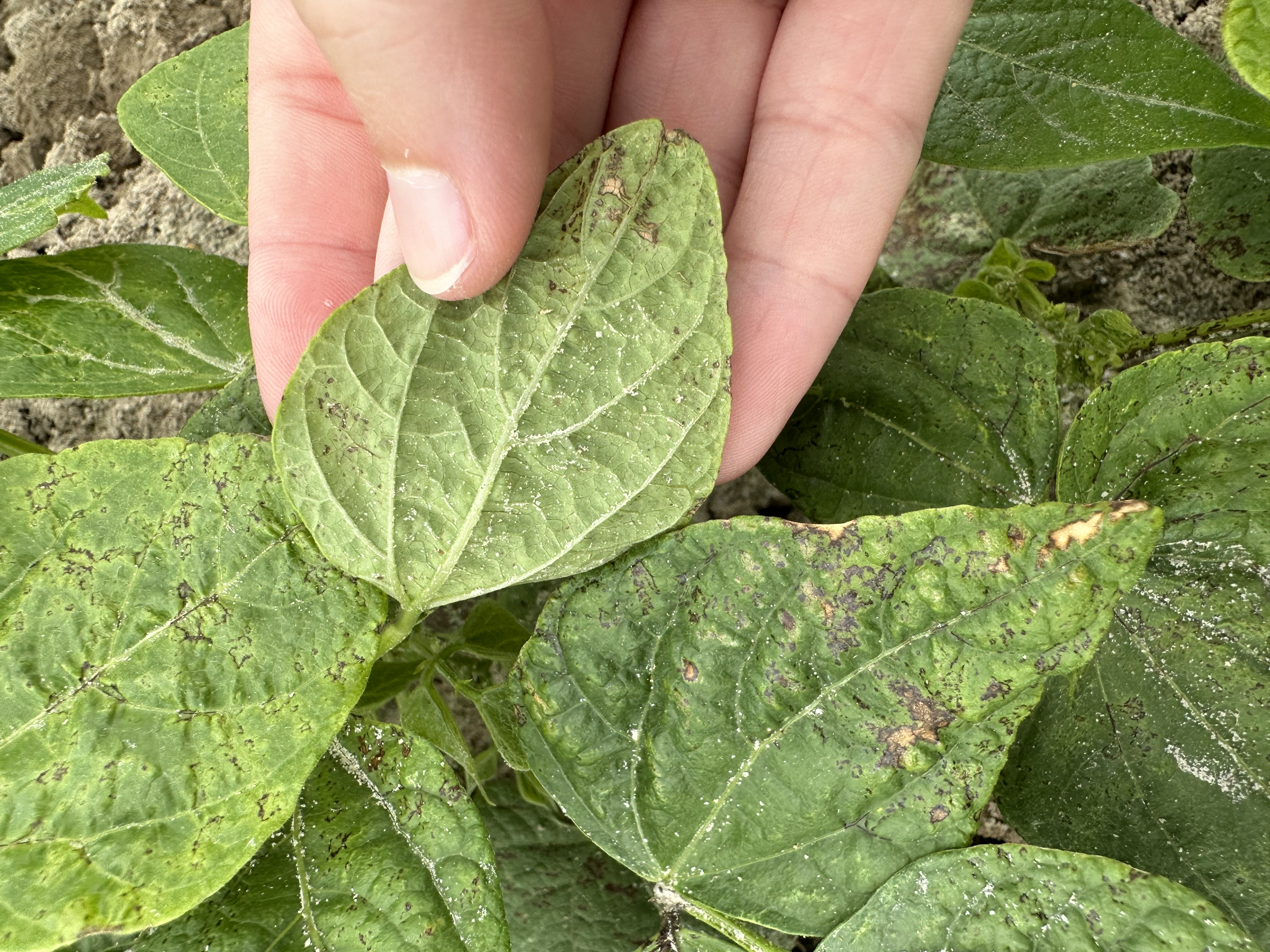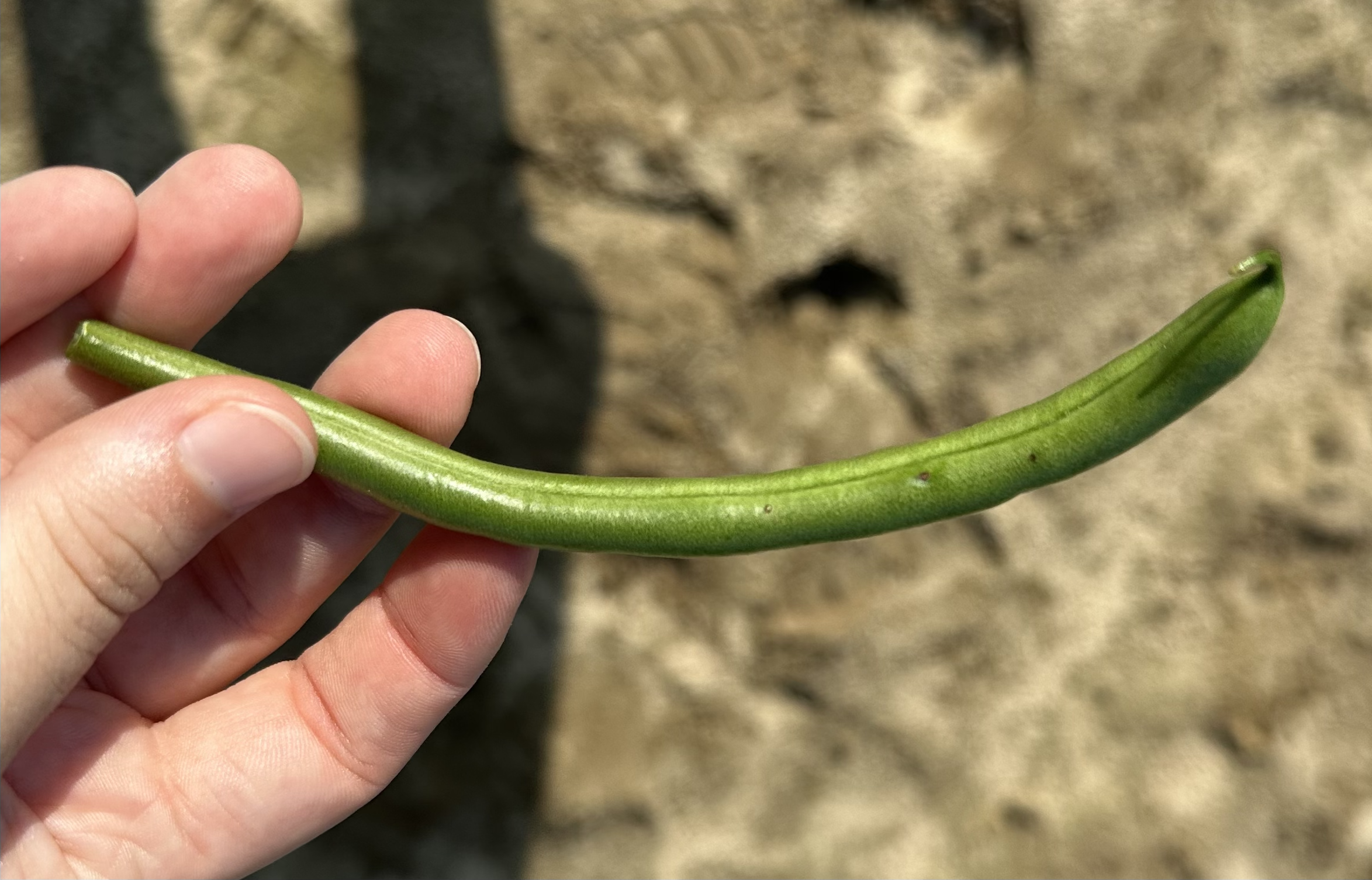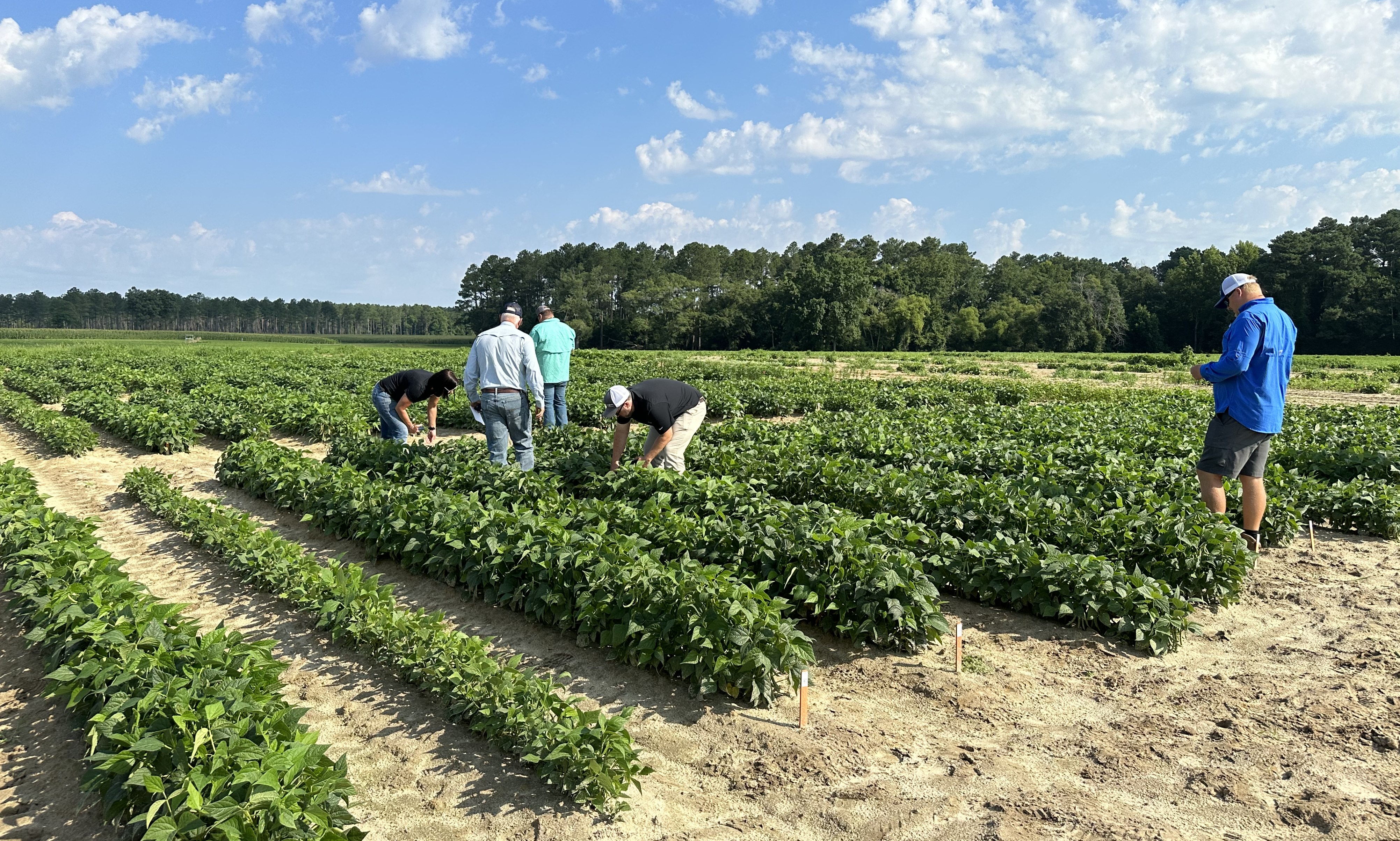| Name | Entering company | Pod type |
|---|---|---|
| Navajo | Crites | flat |
| 857 | Crites | round |
| HM Peary | Harris Moran | round |
| HM Flavor Sweet | Harris Moran | round |
| HM LaSalle | Harris Moran | round |
| HM Bartram | Harris Moran | round |
| HM Caprice | Harris Moran | round |
| HM Byrd | Harris Moran | round |
| HM Valero | Harris Moran | flat |
| HM 4423 | Harris Moran | round |
| RR 7002 | Pure Line | round |
| WAV 75 | Pure Line | round |
| PL 0014 | Pure Line | round |
| PL0136 | Pure Line | round |
| PL0008 | Pure Line | round |
| PL 0070 | Pure Line | round |
| Usambara | Seminis | flat |
| SVGG1312 | Seminis | round |
| SVGF2123 | Seminis | round |
| Stonga | Seminis | flat |
| SB4824 | Syngenta | round |
| Greenback | Syngenta | round |
| SB4829 | Syngenta | round |
Clemson Green Bean Variety Trial Report Spring 2023
Introduction
Clemson’s 2023 Spring Green Bean Variety Trial included 19 round-podded and 4 flat-podded varieties from 5 participating companies. The purpose of the trial was to evaluate varieties for yield, quality, and heat tolerance characteristics in a once-over harvest situation.
Materials and methods
Location
The Clemson 2023 Spring Green Bean Variety Trial was performed in Field 22 at the Clemson Pee Dee Research and Education Center in Florence, South Carolina. The soil type in this field is Noboco loamy sand with a 0-2% slope. It is well-drained, but has a low organic matter content and nutrient holding capacity. This soil type also tends to be highly acidic. This trial was planted following corn.
Cultural practices
Experimental design
The green bean variety trial was planted on May 4, 2023. Varieties were planted in single-row plots with 38-inch inter-row spacing. Plots were 25 feet long and arranged in a randomized complete block design with four replications. Border rows of the standard variety ‘Caprice’ were planted surrounding the trial. The seeding rate was 7 seeds/foot, for an in-row spacing of ~1.7 inches.
Fertility
Standard soil tests were performed by the Clemson Soil Lab prior to planting. Pre-planting soil test results are reported in Table 2 and Table 3. Full soil testing results are available online under Lab ID Numbers 23032170, 23032171, and 23032172. The field was fertilized with 350 lb/acre of 0.7 ton 11-52-0, 0.2285 ton 46-0-0 Urea granular, 1.8210 tons 0-0-60 MOP granular, and 0.66 Ton Microsync pro 50 lb bag prior to planting. On May 9, 1,000lbs/acre of crushed lime were broadcast on the field. Plots were broadcast with 420lb of 15-11-14-11.5 on May 10. Calcium was applied on May 24 at a rate of 3qt/acre.
| Sampling location | pH | lbs/acre | ||||||||
|---|---|---|---|---|---|---|---|---|---|---|
| P | K | Ca | Mg | Zn | Mn | Cu | B | Na | ||
| 22-1 | 5.4 | 86 | 160 | 794 | 112 | 5.6 | 21 | 0.6 | 0.7 | 10 |
| 22-2 | 5.5 | 60 | 113 | 463 | 60 | 4.2 | 16 | 0.6 | 0.6 | 6 |
| 22-3 | 5.6 | 58 | 118 | 324 | 47 | 3.2 | 11 | 0.6 | 0.5 | 2 |
| Sampling location | lbs/acre | ||||||||||
|---|---|---|---|---|---|---|---|---|---|---|---|
| Lime | N | P2O5 | K2O | Ca | Mg | Zn | Mn | Cu | B | S | |
| 22-1 | 2600 | 70-1101 | 20 | 80 | 0 | 0 | 0 | 10 | 0 | 0 | 10 |
| 22-2 | 1600 | 70-1101 | 80 | 120 | 0 | 0 | 0 | 10 | 0 | 0 | 10 |
| 22-3 | 1100 | 70-1101 | 80 | 120 | 0 | 0 | 0 | 10 | 0 | 0 | 10 |
| 1 N recommendations in lb/acre: 25-50 preplant, 20 at planting, sidedress with 25-40 | |||||||||||
Weed, disease, and insect pest control
Pre-emergent herbicides were applied for weed control (Table 4). The trial was cultivated. Weed control on the trial was excellent.
The trial was sprayed weekly with fungicides (Table 4) following the identification of Alternaria leaf spot symptoms on May 31 (Figure 7). Despite these regular applications, Alternaria symptoms were again identified on the pods of most varieties at harvest. No other major disease symptoms were noted in the trial.
Three applications of insecticides were applied to the trial (Table 4).
| Chemical | Class | FRAC/IRAC | Rate | Application date | Comments |
|---|---|---|---|---|---|
| Cruiser (Thiamethoxam) | Insecticide | 4A | - | - | Seed treatment |
| Velum | Fungicide/ nematicide | 7 | 16 fl oz/acre | 5/4 | In-furrow at planting |
| Subtilex NG + HiStick L | Rhizobial inoculant & biological fungicide | 44 | 12.5 fl oz/acre | 5/4 | In-furrow at planting |
| Reflex | Herbicide | 14 | 1.5 pints/acre | 5/5 | Pre-emergence |
| Dual Magnum | Herbicide | 15 | 1.5 pints/acre | 5/5 | Pre-emergence |
| Roundup | Herbicide | 9 | 22 fl oz/acre | 5/9 | - |
| Crushed lime | Soil amendment | - | 1000 lb/acre | 5/9 | - |
| Acephate | Insecticide | 1 | 8 fl oz/acre | 5/25 | - |
| Select (clethodim) | Herbicide | 2 | 12 fl oz/acre | 5/25 | - |
| Bravo (chlorothalonil) | Fungicide | M05 | 22 fl oz/acre | 6/2 | - |
| Quilt Xcel | Fungicide | 3&11 | 11 fl oz/acre | 6/11 | - |
| Dimethoate | Insecticide | 1B | 6 fl oz/acre | 6/11 | - |
| Bracket 97 (acephate) | Insecticide | 1 | 8 fl oz/acre | 6/17 | - |
| Sysstem K | Fertilizer/Fungicide | 33 | 2-3 qts/acre | 6/19 | - |
| Fontelis | Fungicide | 7 | 18 fl oz/acre | 6/26 | - |
Irrigation
The trial was overhead irrigated as necessary with a traveling linear system as needed (Figure 2).
Weather
Daily weather was recorded by the PDREC front compound weather station. Minimum and maximum temperatures for each day are presented in Figure 1 and rain accumulation in Figure 2.

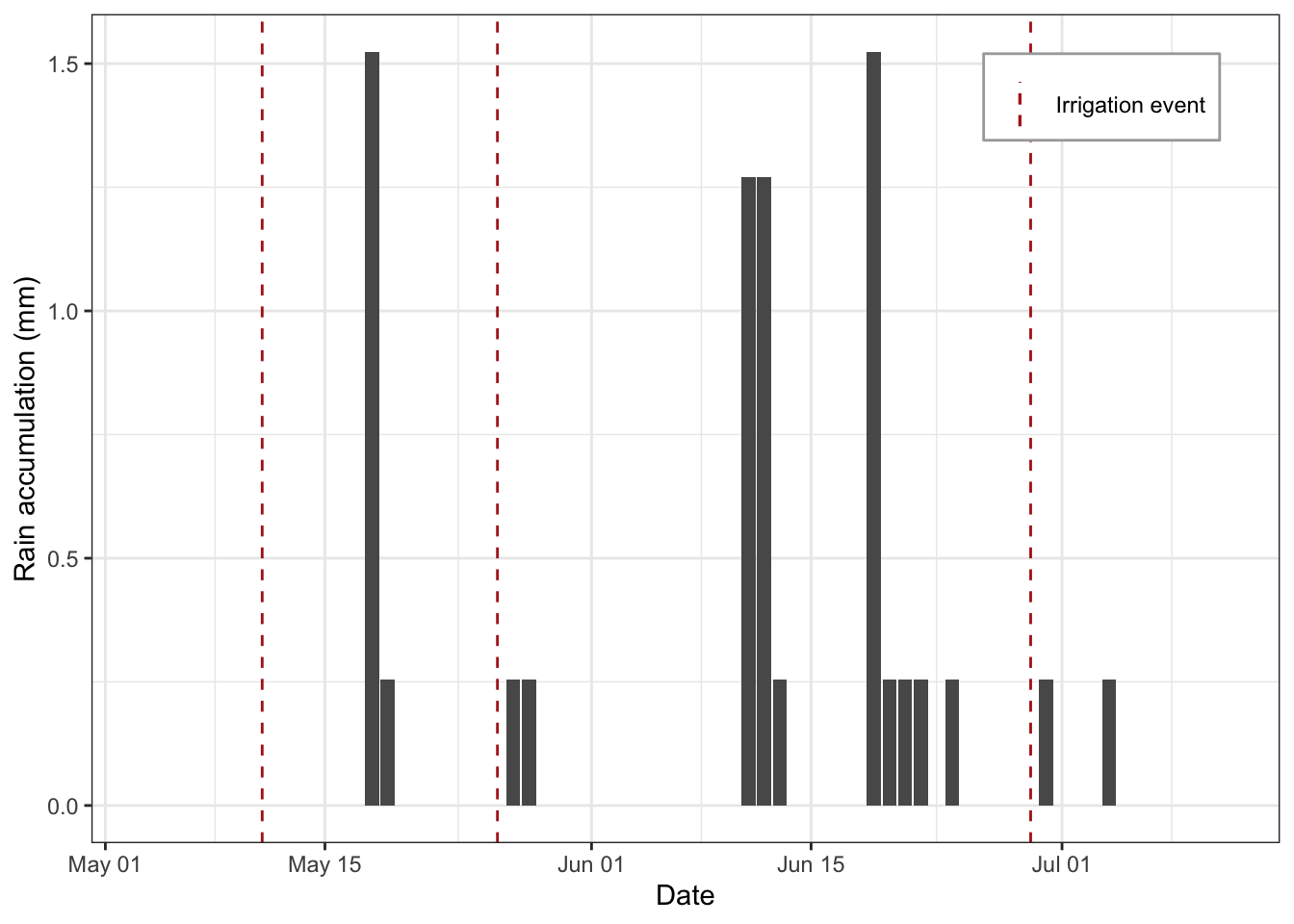
Phenotyping
Pre-harvest
Stand counts were recorded as the number of germinated plants at two weeks after planting. Flowering time represents the date at which approximately 10% of the plants in a plot started flowering.
Harvest
To determine a variety’s maturity, the most mature pod was removed from each of ten random plants from a plot. The center seed from each of the ten pods was removed and lined up end to end. A variety was considered ready for harvest when the line of seeds measured 9-11.2 cm (i.e. average seed length of 9 to 11.2 mm).
Harvest of the trial began on June 29, 2023 (56 DAP) and was completed on July 11, 2023 (68 DAP). Plants were pulled from a random 3-foot section of each plot and all pods were removed by hand. When possible, this sample was taken from the middle third of each plot.
For round-podded varieties, pods were graded into three categories by sieve size; size three and under; size four, and size five. The total pod weight for each category was recorded. Additive center seed length of 10 size four pods was recorded for each plot.
For flat podded varieties, only seed length and total pod weight were measured.
Two images were taken at harvest for each plot: one of all harvested pods sorted into sieve sizes and one of a split bean next to ten seeds lined up end to end on a ruler. These images are available on Google Drive.
Results
Stand counts, flowering time, and yields are reported separately by pod type in Table 5 and Table 6. Stand counts are presented in Figure 6 and flowering date is shown in Figure 4.
Figure 3 shows mean yields for each variety of both pod types, with sieve size proportions indicated for round-podded varieties. The correlation between stand count and yield was 0.1.
| Variety | Stand count | Days to flowering | Seed length (mm) | Yield (lbs/acre) | Sieve size 3 and under (lbs/acre) | Sieve size 4 (lbs/acre) | Sieve size 5 (lbs/acre) |
|---|---|---|---|---|---|---|---|
| SB4824 | 213.5 a | 36 h | 11.45 bcd | 3278.64 abcde | 1860.76 a | 1300.54 bcdef | 117.33 e |
| SB4829 | 193.25 ab | 36 h | 13.15 a | 3110.23 bcdef | 1093.5 bcd | 1465.32 abcd | 551.41 cde |
| Greenback | 178.25 bc | 36.25 gh | 12.35 ab | 3240.43 bcde | 819.28 cdef | 1509.62 abcd | 911.53 bcd |
| HM Caprice | 168 cd | 38.5 abcde | 12.15 abc | 2924.7 bcdefg | 522.78 ef | 1414.06 abcde | 987.86 bcd |
| WAV 75 | 165.25 cde | 39 abc | 9.93 d | 1845.09 h | 1231.5 bc | 584.87 hi | 28.72 e |
| RR 7002 | 155.25 def | 37.5 defg | 13.18 a | 3805.86 ab | 934.66 cdef | 1775.29 ab | 1095.92 bc |
| HM Peary | 154.25 def | 36.25 gh | 11.32 bcd | 3493.22 abc | 585.8 def | 1480.06 abcd | 1427.36 ab |
| SVGG1312 | 154.25 def | 38 bcdef | 10.57 cd | 3485.85 abc | 942.37 cdef | 1635.42 abc | 908.06 bcd |
| HM Byrd | 153 defg | 36 h | 12.22 abc | 3059.57 bcdef | 745.66 cdef | 1437.02 abcd | 876.88 bcd |
| HM 4423 | 146.25 defgh | 38 bcdef | 12.53 ab | 2163.79 fgh | 707.29 cdef | 899.93 efghi | 556.58 cde |
| SVGF2123 | 143.25 efghi | 38.75 abcd | 11.3 bcd | 3354.71 abcd | 1075.54 bcde | 1448.12 abcd | 831.05 bcd |
| PL0008 | 142.5 fghi | 36.25 gh | 11.45 bcd | 4267.01 a | 702.8 cdef | 1847.04 a | 1717.17 a |
| HM LaSalle | 140.25 fghi | 39.25 ab | 13.28 a | 2478.59 defgh | 920.94 cdef | 1167.37 cdefg | 390.28 de |
| PL 0070 | 140 fghi | 37 fgh | 11.25 bcd | 2575.76 cdefgh | 1538.59 ab | 996.76 defgh | 40.41 e |
| HM Bartram | 136.25 fghi | 36.25 gh | 13.47 a | 1937.69 gh | 867.91 cdef | 869.43 fghi | 200.35 e |
| HM Flavor Sweet | 131 ghi | 39.5 a | 11.32 bcd | 1974.62 gh | 1598.83 ab | 375.8 i | 0 e |
| PL 0014 | 130.5 ghi | 37.75 cdef | 11.2 bcd | 2343.47 efgh | 962.79 cdef | 1189.06 cdefg | 191.63 e |
| 857 | 125.5 hi | 37.25 efgh | 12.32 ab | 2757.05 cdefgh | 486.94 f | 1309.36 bcdef | 960.75 bcd |
| PL0136 | 121.5 i | 36 h | 10.57 cd | 1992.41 gh | 1139.42 bcd | 738.46 ghi | 114.53 e |
| Mean | 152.21 | 37.34 | 11.86 | 2846.77 | 986.18 | 1233.87 | 626.73 |
| Coefficient of variation | 10.51 | 2.57 | 10.07 | 24.85 | 40.6 | 30.54 | 68.75 |
| Fisher's LSD1 | 22.68 | 1.36 | -2 | 1002.28 | 567.33 | 533.98 | 610.55 |
| p-value | 0 | 0 | 0 | 0 | 0 | 0 | 0 |
| 1 Means followed by the same letter are not significantly different according to Fisher’s LSD. | |||||||
| 2 LSD cannot be calculated for an unbalanced dataset. | |||||||
| Variety | Stand count | Days to flowering | Seed length (mm) | Yield (lbs/acre) |
|---|---|---|---|---|
| Usambara | 134.5 a | 36 b | 10.73 ab | 5796.12 a |
| Stonga | 133.25 a | 36 b | 11.38 ab | 4281.41 ab |
| Navajo | 128 a | 36 b | 12.5 a | 3439.6 bc |
| HM Valero | 82 b | 37.75 a | 9.32 b | 2499.94 c |
| Mean | 119.44 | 36.44 | 11 | 4004.27 |
| Coefficient of variation | 13.41 | 2.16 | 14.93 | 25.45 |
| Fisher's LSD1 | 25.24 | 1.24 | -2 | 1605.79 |
| p-value | 0 | 0.02 | 0.12 | 0.01 |
| 1 Means followed by the same letter are not significantly different according to Fisher’s LSD. | ||||
| 2 LSD cannot be calculated for an unbalanced dataset. | ||||
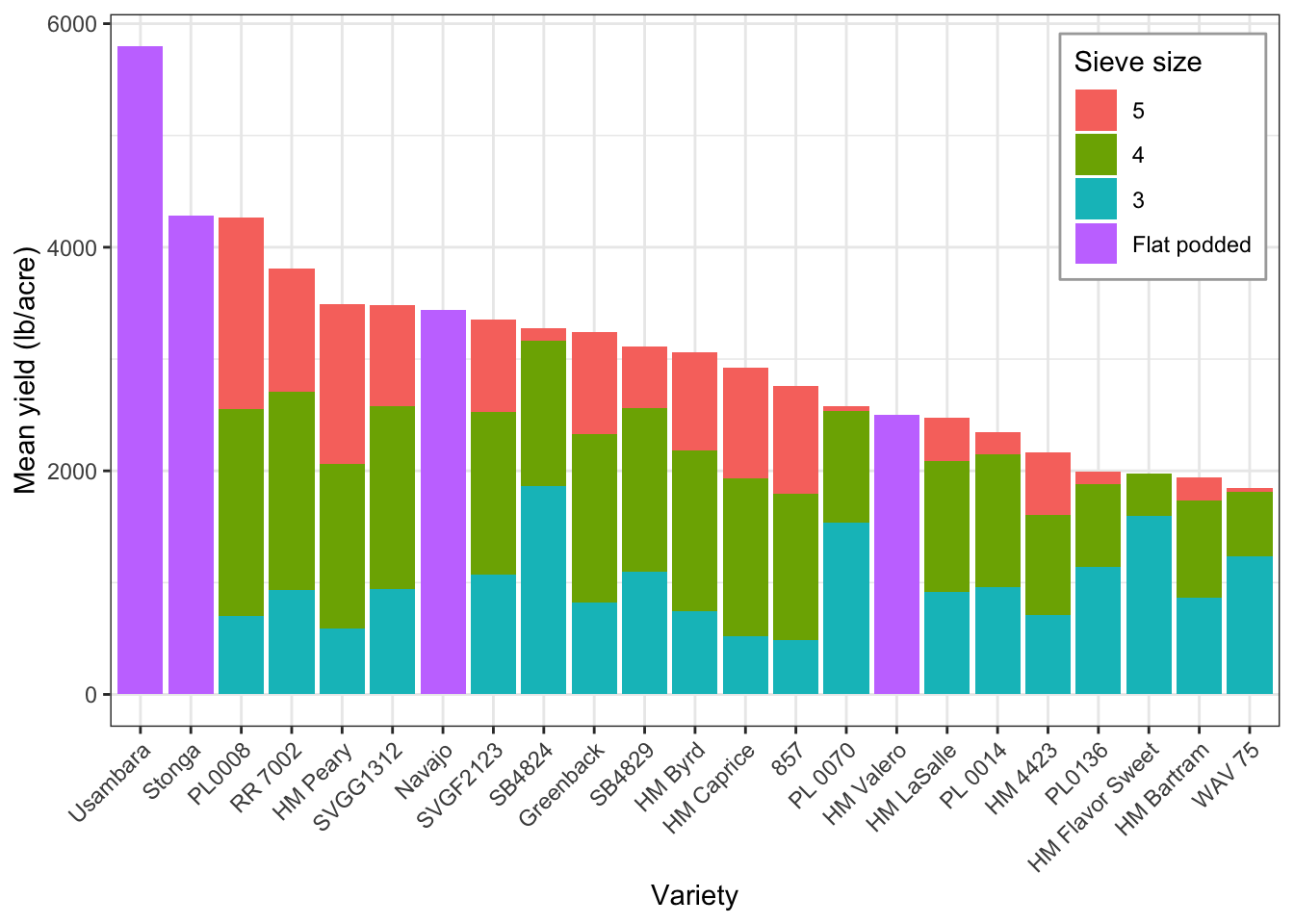
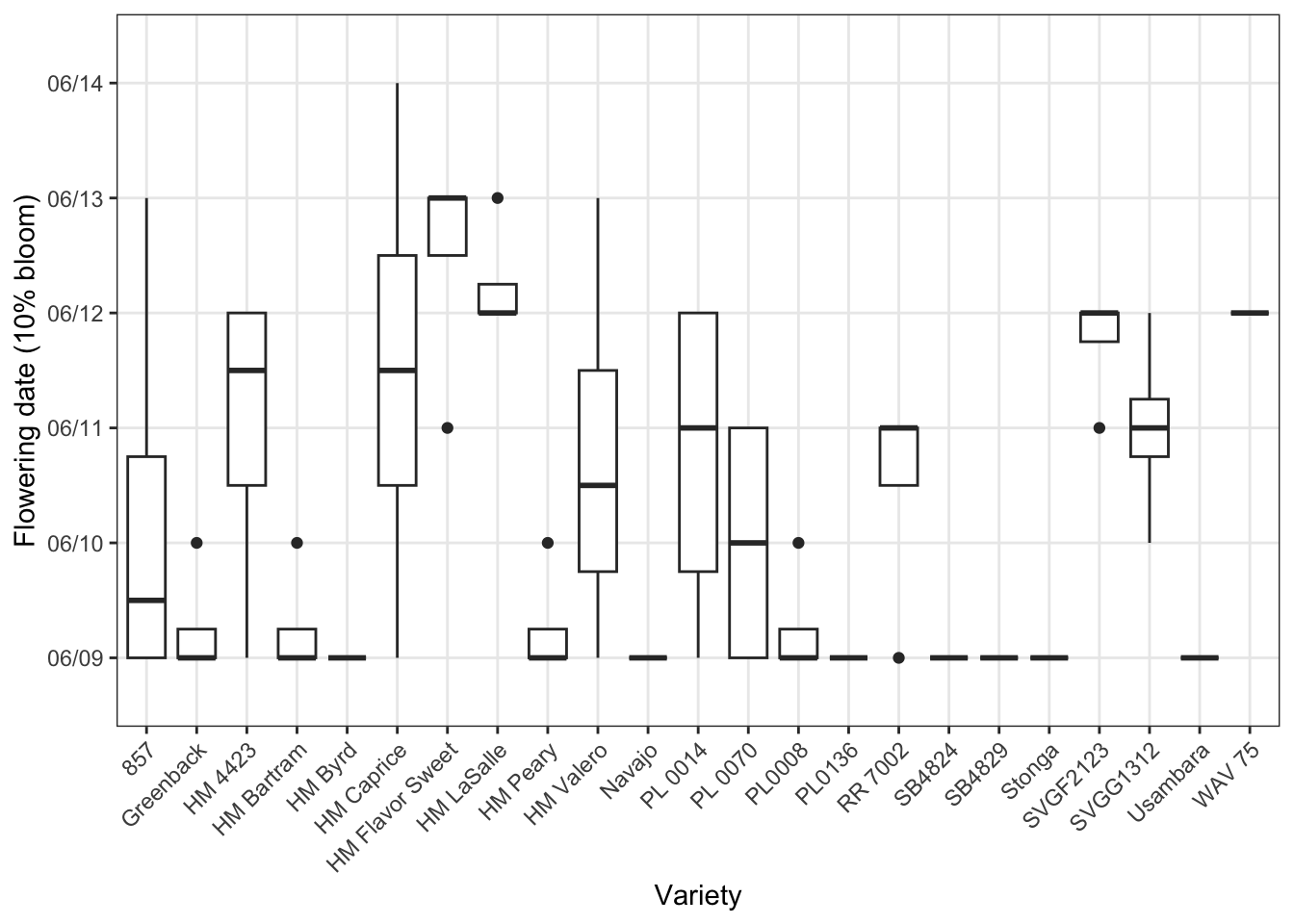
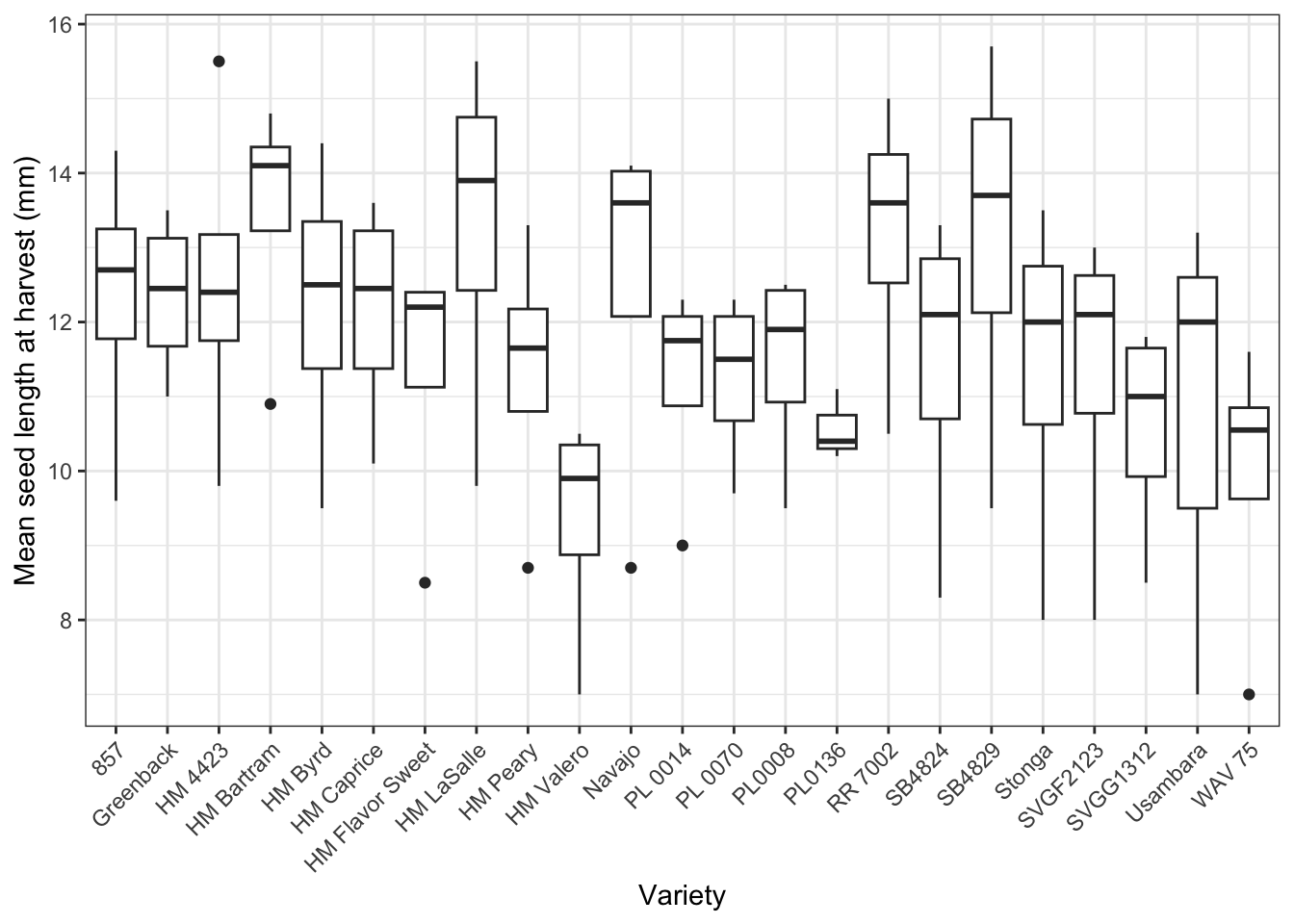
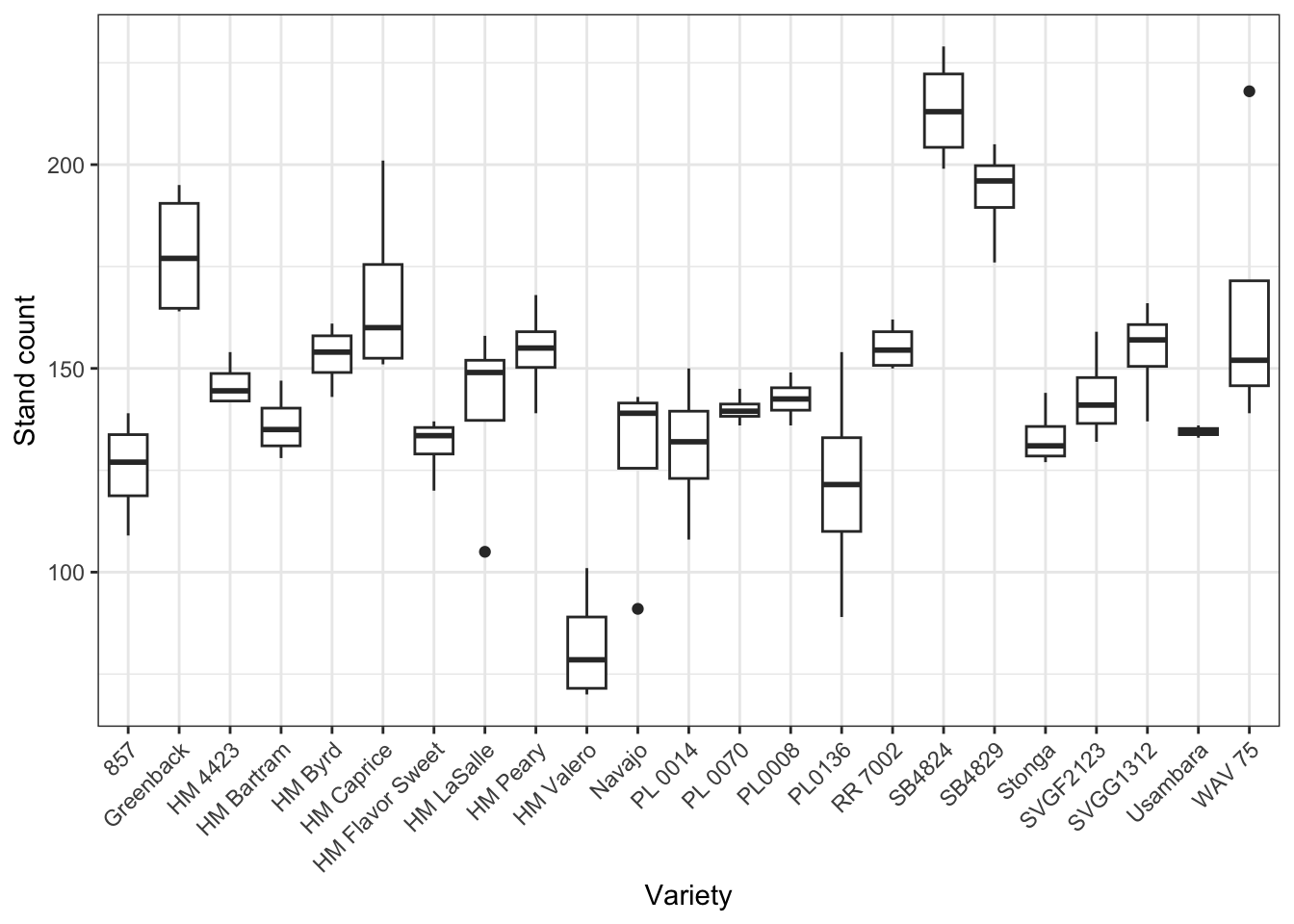
Discussion
The trial had good emergence and stand establishment for most varieties. Stand counts were above the expected number of seeds planted (n = 175) in 12 of the plots in this trial. Because the seeds were packed by individual companies and sealed until planting, the number of seeds was not verified by Clemson prior to planting. Assuming the number of seeds in each packet was consistent at 175, the increased stand count is most likely due to planter error with spillover from one plot to the next. If this is the case, the ends of the plots are most likely to contain seeds from the previous plot, so only the middle third of each plot was phenotyped.
Stand count and yield were not highly correlated in this trial (\(r = 0.1\)).
Florence experienced an abnormally cool spring during this trial.
The round-podded variety with the highest yield was PL0008 (4267 lb/acre), but the yield of this variety was not significantly different from that of RR 7002 (3806 lb/acre), HM Peary (3493 lb/acre), or SVGF2123 (3355 lb/acre). PL0008 was the only variety with a total yield significantly above that of standard variety HM Caprice.
The flat podded variety with the highest yield was Usambara (5796 lb/acre), but the second highest-yielding variety, Stonga (4281 lb/acre), was not significantly different (Table 3). The small number of flat podded varieties limits the ability to provide further insight.
Many pods were marked with small brown dots at harvest (Figure 8). In many cases, every bean within a plot was affected despite regular fungicide applications. A sample of these pods was sent for examination by the Clemson Plant Disease Diagnostic Clinic, who identified it as Alternaria leaf and pod spot (ALPS) caused by the fungal pathogen Alternaria alternata. According to a factsheet from the University of Florida, high humidity and cool temperatures like those experienced at the PDREC this spring are ideal conditions for ALPS. Beans under nutritional stress are particularly susceptible to this disease. Given the low pH of the soil for this trial, it is likely that the beans were not able to take up the nutrients provided by the fertilizer applications and were therefore under considerable nutrient stress. Earlier soil amendment with lime will likely help with future management of ALPS by encouraging improved nutrient update.
Acknowledgements
The authors gratefully acknowledge:
Participating seed companies
Stewart Higgins for organizing entry selection and shipping logistics and providing management decision support
Chuck Parker and the PDREC farm crew for trial management advice and assistance
Bruce McLean, Clemson Area Commercial Horticulture Extension Agent, for pesticide spray plan recommendations
Clemson PDREC vegetable breeding program employees
Photos
